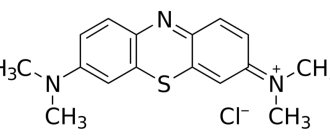Composition and release form
The drug is dispensed in the form of tablets and solution for injection.
The active ingredient is metoclopramide hydrochloride. Excipients:
- Saline.
- Acetic acid.
- Water for injections.
- Sodium sulfite.
- Edetate disodium.
Sold without a doctor's prescription. The cardboard package contains 1 bottle of clear liquid or 1-5 blisters of 10 tablets with attached instructions.
Shelf life 2 years. Optimal conditions are temperatures up to +25 C, in a dark place, away from children.
Interaction
Cholinesterase inhibitors weaken the effect of the drug. The risk of developing extrapyramidal disorders increases significantly with simultaneous therapy with antipsychotics.
Metoclopramide can increase the activity of histamine H2 receptor blockers, enhance the sedative effect of hypnotics, and aggravate the effect of ethanol on the nervous system. The drug enhances absorption:
- Tetracycline (including tetracycline antibiotics);
- ethanol;
- Levodopa;
- Acetylsalicylic acid;
- Paracetamol;
- Diazepam.
Metoclopramide Vial slows down the absorption of the following drugs:
- Cimetidine;
- Digoxin.
pharmachologic effect
Metoclopramide is a serotonin and dopamine receptor antagonist. It has a pronounced anti-hiccup, antiemetic and prokinetic effect. Stimulates intestinal motility in the upper section and regulates sphincter function.
The drug improves the tone of muscle contractions of the stomach, helps relax the duodenum and helps speed up the digestion process. It also has a positive effect on the functioning of the gallbladder, eliminating its disorder.
The antiemetic therapeutic effect is based on the suppression of dopamine receptors in the peripheral and central regions. Therefore, the medicine is effective in suppressing nausea and the gag reflex of various natures, namely due to anesthesia, chemotherapy, and taking certain groups of drugs when side effects occur.
The drug inhibits the effect of apomorphine, increasing the production of prolactin and increasing the content of aldosterone. Therefore, there is a temporary retention of fluid in the body.
When administered orally, the medicine is quickly absorbed into the bloodstream and reaches its maximum therapeutic effect after 1-2 hours. The overall bioavailability is 80%.
The half-life is 6 hours, in case of kidney disease it increases to 14 hours.
When the drug is administered by injection, the pharmacological effect is observed 1-3 minutes after intravenous administration and 15 minutes after intramuscular administration. Duration is 2 hours.
Metoclopramide price, where to buy
Price for Metoclopramide tablets
In Ukraine, the drug can be purchased for 28 UAH (Metoclopramide-Darnitsa).
The price of Metoclopramide in injections in Russia is 70 rubles.
- Online pharmacies in RussiaRussia
- Online pharmacies in UkraineUkraine
- Online pharmacies in KazakhstanKazakhstan
ZdravCity
- Metoclopramide-Vial solution for intravenous and intramuscular injection.
5mg/ml amp. 2ml No. 10 CSP Oui Pharmaceutical Co. Ltd. 49 RUR order
Pharmacy Dialogue
- Metoclopramide Welfarm (d.i.v. and intramural solution 5 mg/ml 2 ml No. 10) Welfarm LLC
42 RUR order
- Metoclopramide (10 mg tablet No. 56)Update of PFC JSC
39 RUR order
- Metoclopramide (amp. 0.5% 2ml No. 10)Novosibkhimpharm OJSC
52 RUR order
show more
Pharmacy24
- Metoclopramide-Darnitsa 0.5% 2 ml No. 10 solution
41 UAH. order - Metoclopramide-Darnitsa 0.01 g No. 50 tablets PrAT" Pharmaceutical company "Darnitsa", Ukraine
41 UAH order
- Metoclopramide hydrochloride 5 mg/ml 2 ml No. 10 solution for injection
36 UAH order
PaniPharmacy
- Metoclopramide ampoule Metoclopramide solution for injection 0.5% ampoule 2ml No. 10 Ukraine, Darnitsa ChAO
45 UAH order
- Metoclopramide tablets Metoclopramide tablets. 10mg No. 50 Ukraine, Darnitsa ChAO
45 UAH order
- Metoclopramide ampoule Metoclopramide solution for injection 5 mg/ml ampoule 2 ml No. 10 Ukraine, Borshchagovsky Chemical Plant PJSC
34 UAH order
- Metoclopramide ampoule Metoclopramide solution for injection 0.5% ampoule 2ml No. 10 Ukraine, Health LLC
34 UAH order
- Metoclopramide tablets Metoclopramide tablets. 10mg No. 50 Ukraine, Health LLC
44 UAH order
show more
Indications
Clinical conditions for which metoclopramide is indicated are:
- Nausea.
- Vomiting of various origins.
- Dysfunction of the digestive system.
- Atony and hypotension of the intestines and stomach.
- Postoperative gastrointestinal disorders.
- Increased gas formation.
- The period of exacerbation of ulcerative pathology of the gastrointestinal tract.
- Preparation for examination of the digestive system.
- Diseases of the biliary tract.
Contraindications
- intestinal obstruction of a mechanical nature;
- stenosis of the pylorus of the stomach;
- bleeding in the digestive system;
- perforation of the walls of the intestine, stomach;
- diagnosed glaucoma , suspicion of it;
- epilepsy;
- pheochromocytoma;
- bronchial asthma in patients with hypersensitivity to sulfites;
- prolactin-dependent neoplasms;
- Parkinson's disease;
- extrapyramidal disorders;
- vomiting during treatment with antipsychotics in patients suffering from breast cancer;
- individual hypersensitivity.
The drug is not used in the postoperative period in patients with pyloroplasty and intestinal anastomosis, because Vigorous muscle contractions impair healing.
Relative contraindications:
- childhood (possible development of dyskinetic syndrome);
- old age (65 years and older);
- Parkinson's disease;
- bronchial asthma;
- diseases of the kidney and liver system;
- hypertonic disease.
Mode of application
Depending on the form of the drug, Metoclopramide has some application features:
- Oral method - take half an hour before meals, do not chew the tablets, be sure to wash them down with water. The maximum duration of treatment for vomiting and nausea is up to 5 days. Intervals between doses of the drug should be at least 6 hours. The dosage of the drug is calculated individually, according to age, body weight and pronounced clinical picture. Do not exceed the amount of medication above 0.5 mg/kg. The optimal adult dosage is 10 mg 3 times a day.
- Injection method - the drug is prescribed for a course of 5 days. The solution is administered intravenously or intramuscularly over 3 minutes. Dosage for adults: 10 mg once or 30 mg 3 times a day.
In childhood, the use of Metoclopramide is possible from 2 years of age. If you weigh less than 60 kg, 0.1-0.15 mg/kg of the drug is indicated three times a day. Children over 15 years old weighing more than 60 kg are prescribed 10 mg 3 times a day.
Elderly people should reduce the therapeutic dose, taking into account the deterioration of the liver and excretory system.
Patients with kidney pathologies should use the drug with caution. The dose is reduced by 75% or 50% depending on the condition.
If liver function is impaired, take 10 mg once, or reduce the dosage by half.
Metoclopramide
Contraindicated combinations
The simultaneous use of metoclopramide with levodopa or dopamine receptor agonists is contraindicated due to the existing mutual antagonism.
Combinations to Avoid
Alcohol enhances the sedative effect of metoclopramide.
Combinations requiring caution
Due to the prokinetic effect of metoclopramide, the absorption of some drugs may be impaired.
M-anticholinergic agents and morphine derivatives have mutual antagonism with metoclopramide in terms of their effect on gastrointestinal motility.
Medicines that depress the central nervous system (morphine derivatives, tranquilizers, H1-histamine receptor blockers, antidepressants with sedative effects, barbiturates, clonidine and other drugs of these groups) can enhance the sedative effect under the influence of metoclopramide.
Metoclopramide enhances the effect of antipsychotics on extrapyramidal symptoms.
With the concomitant use of metoclopramide and tetrabenazine orally, there is a possibility of dopamine deficiency, which may be accompanied by muscle spasms, difficulties in speaking or swallowing, anxiety, tremor, involuntary muscle movements, including facial muscles.
The use of metoclopramide with serotonergic drugs, such as selective serotonin reuptake inhibitors, increases the risk of developing serotonin syndrome (serotonin toxicity).
Metoclopramide reduces the bioavailability of digoxin, and monitoring of digoxin plasma concentrations is required.
Metoclopramide enhances the absorption of tetracycline, ampicillin, paracetamol, acetylsalicylic acid, mexiletine, lithium, levodopa, ethanol and cyclosporine (Cmax by 46% and effect by 22%, which requires monitoring of the concentration of cyclosporine in the blood plasma); reduces the absorption of cimetidine.
Metoclopramide exposure increases when used concomitantly with strong CYP2D6 inhibitors, such as fluoxetine and paroxetine. Although the clinical significance of this interaction has not been established, patients should be monitored for adverse reactions.
With the concomitant use of metoclopramide with atovaquone, the concentration of atovaquone in the blood plasma is significantly reduced (about 50%). Concomitant use of metoclopramide with atovaquone is not recommended.
With the concomitant use of metoclopramide with bromocriptine, the concentration of bromocriptine in the blood plasma increases.
Metoclopramide solution is pharmaceutically (physically and chemically) compatible (up to 48 hours) with solutions of cimetidine, mannitol, potassium acetate and potassium phosphate; physically compatible (up to 48 hours) with solutions of ascorbic acid, benztropine mesylate, cytarabine, dexamethasone sodium phosphate, diphenhydramine, doxorubicin, sodium heparin, hydrocortisone sodium phosphate, lidocaine hydrochloride, solutions of multivitamins (if stored in the refrigerator), solutions of B vitamins, with ascorbic acid.
Metoclopramide solution is physically compatible for up to 24 hours (do not use if precipitation occurs) with clindamycin phosphate, cyclophosphamide, insulin.
Conditionally compatible (use within one hour of mixing or can be infused directly into the same venous line) with ampicillin sodium, cisplatin, erythromycin lactobionate, methotrexate sodium, benzylpenicillin potassium, tetracycline hydrochloride.
Incompatible (do not combine!) with cephalothin sodium, chloramphenicol sodium, sodium bicarbonate.
Side effects
The antiemetic may cause the following side effects:
- Constipation, dry mouth, profuse diarrhea.
- Feelings of drowsiness, malaise, headache and dizziness during the initial period of therapy.
- Tension of the facial muscles.
- Symptoms of parkinsonism and dyskinesia with prolonged use.
- Hormonal imbalance.
- Allergic manifestations.
Overdose
In case of non-compliance with the therapeutic dose, an overdose is possible. It manifests itself with a pronounced clinical picture in the form of nervous disorders. Hallucinations and unclear consciousness are noted.
Rarely - deterioration of the cardiovascular system with a decrease in blood pressure, the appearance of bradycardia, even cardiac arrest.
Signs of an overdose last a day after starting to take the drug.
Treatment based on symptoms, medication with monitoring of cardiac and respiratory function.



